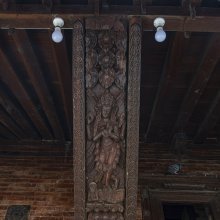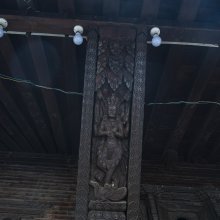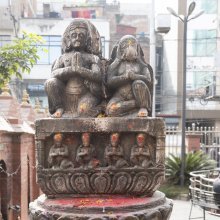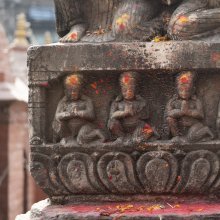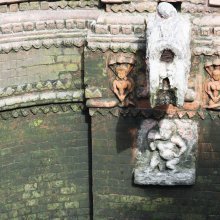Preta: 27 definitions
Introduction:
Preta means something in Buddhism, Pali, Hinduism, Sanskrit, the history of ancient India, Marathi, Hindi. If you want to know the exact meaning, history, etymology or English translation of this term then check out the descriptions on this page. Add your comment or reference to a book if you want to contribute to this summary article.
Alternative spellings of this word include Pret.
Images (photo gallery)
(+31 more images available)
In Hinduism
Purana and Itihasa (epic history)
Source: archive.org: Shiva Purana - English TranslationPreta (प्रेत) refers to a “ghost” and represents the mount of Nirṛti, according to the Śivapurāṇa 2.2.36. Accordingly, as Brahmā narrated to Nārada:—“Indra mocked at Viṣṇu who was engrossed in his own arguments. He, the bearer of the thunderbolt, was desirous of fighting Vīrabhadra along with the other Devas. Then Indra rode on his elephant, the fire-god rode on a goat, Yama rode on his buffalo and Nirṛti rode on a ghost (preta)”.
Source: Cologne Digital Sanskrit Dictionaries: The Purana IndexPreta (प्रेत).—Spirits harassing children.*
- * Bhāgavata-purāṇa II. 6. 43; 10. 38; VI. 8. 25; X. 6. 27; 63. 11; XI. 10. 28.

The Purana (पुराण, purāṇas) refers to Sanskrit literature preserving ancient India’s vast cultural history, including historical legends, religious ceremonies, various arts and sciences. The eighteen mahapuranas total over 400,000 shlokas (metrical couplets) and date to at least several centuries BCE.
Dharmashastra (religious law)
Source: Manblunder: Garuda Purana series (dharmashastra)Preta (प्रेत).—The preta body of dead is formed only on offering piṇḍas. For example, on the first day of piṇḍa offering, the head of the preta body becomes piṇḍa body, on the second day of offering neck and shoulders become piṇḍa body and so on. On the tenth day, the entire preta body is converted into piṇḍa body or piṇḍa-śarīra (śarīra means body).
Piṇḍa is offered everyday during the first ten days along with water, honey, ghee, sesame seeds, etc. Piṇḍas are also offered on the day of sapiṇḍīkaraṇa. On taking this piṇḍa, the preta-śarīra becomes a pitṛ and can reach the world of ancestors. It is said that a deceased person cannot reach the world of ancestors with preta-śarīra. A preta eats food twice, on eleventh and twelfth days.

Dharmashastra (धर्मशास्त्र, dharmaśāstra) contains the instructions (shastra) regarding religious conduct of livelihood (dharma), ceremonies, jurisprudence (study of law) and more. It is categorized as smriti, an important and authoritative selection of books dealing with the Hindu lifestyle.
Shaktism (Shakta philosophy)
Source: Google Books: ManthanabhairavatantramPretavigraha (प्रेतविग्रह) refers to a “ghost” (i.e., the Goddess’s vehicle), according to the Manthānabhairavatantra, a vast sprawling work that belongs to a corpus of Tantric texts concerned with the worship of the goddess Kubjikā.—Accordingly, “Consciousness (caitanya) is said to be (of three kinds) gross, very subtle and Unstruck Sound. The Body (piṇḍa) made of these principles is the differentiated (sakala) (aspect) whose form is the ghost [i.e., preta-vigraha] (which is the Goddess’s vehicle). Complete and made of the six parts (noted below), it is sustained by Pure Knowledge (śuddhavidyā). Above it is the measure (called) Sound (nādamātrā), which is just a straight (line) (ṛjumātrā). [...]”.
Source: Brill: Śaivism and the Tantric Traditions (shaktism)Preta (प्रेत) refers to “ghosts”, according to the Mahābhārata 10.8.64–68.—Accordingly, “Good sir, they saw her, Kālarātri, standing, smiling, alone, blue-black in hue, with red mouth and eyes, garlands and unguents of crimson, red robes, a noose in one hand, a peacock feather [in her hair], binding men, horses and elephants with her horrifying fetters while she stood, capturing many headless ghosts (preta) trapped in her noose, leading those asleep in their dreams to other Nights. And at all times the best soldiers saw the son of Droṇa slaughtering. From the time when the battle between the Kuru and Pāṇḍava armies began, they saw [both] that evil spirit and the son of Droṇa. The son of Droṇa later felled those who had first been struck by this divinity [Kālarātri], terrorizing all creatures while shouting out ferocious bellows”.

Shakta (शाक्त, śākta) or Shaktism (śāktism) represents a tradition of Hinduism where the Goddess (Devi) is revered and worshipped. Shakta literature includes a range of scriptures, including various Agamas and Tantras, although its roots may be traced back to the Vedas.
In Buddhism
Theravada (major branch of Buddhism)
Source: Access to Insight: A Glossary of Pali and Buddhist TermsA "hungry shade" or "hungry ghost" - one of a class of beings in the lower realms, sometimes capable of appearing to human beings. The petas are often depicted in Buddhist art as starving beings with pinhole sized mouths through which they can never pass enough food to ease their hunger.Source: Dhamma Dana: Pali English GlossaryM Being living in the compound of apaya worlds, situated between the world of animals and the world of hells.
Source: Pali Kanon: Manual of Buddhist Terms and Doctrines(Sanskrit preta): lit. 'departed spirit', ghost; s. loka.
Theravāda is a major branch of Buddhism having the the Pali canon (tipitaka) as their canonical literature, which includes the vinaya-pitaka (monastic rules), the sutta-pitaka (Buddhist sermons) and the abhidhamma-pitaka (philosophy and psychology).
Tibetan Buddhism (Vajrayana or tantric Buddhism)
Source: Wisdom Library: Tibetan BuddhismPreta (प्रेत) is the name of a Rāśi (zodiac sign) mentioned as attending the teachings in the 6th century Mañjuśrīmūlakalpa: one of the largest Kriyā Tantras devoted to Mañjuśrī (the Bodhisattva of wisdom) representing an encyclopedia of knowledge primarily concerned with ritualistic elements in Buddhism. The teachings in this text originate from Mañjuśrī and were taught to and by Buddha Śākyamuni in the presence of a large audience (including Preta).
Source: academia.edu: The Structure and Meanings of the Heruka MaṇḍalaPreta (प्रेत) is the name of a Vīra (hero) who, together with the Ḍākinī named Pretī forms one of the 36 pairs situated in the Cittacakra, according to the 10th century Ḍākārṇava chapter 15. Accordingly, the cittacakra refers to one of the three divisions of the nirmāṇa-puṭa (‘emanation layer’), situated in the Herukamaṇḍala. The 36 pairs of Ḍākinīs and Vīras [viz., Preta] are black in color; they each have one face and four arms; they hold a skull bowl, a skull staff, a small drum, and a knife.

Tibetan Buddhism includes schools such as Nyingma, Kadampa, Kagyu and Gelug. Their primary canon of literature is divided in two broad categories: The Kangyur, which consists of Buddha’s words, and the Tengyur, which includes commentaries from various sources. Esotericism and tantra techniques (vajrayāna) are collected indepently.
Mahayana (major branch of Buddhism)
Source: Wisdom Library: Maha Prajnaparamita SastraPreta (प्रेत) refers to “hungry ghosts”, according to Mahāprajñāpāramitāśāstra (chapter 36).—Accordingly, “If the Bhikṣu thinks about his own virtues of abandonment and discipline, his fear also disappears. Actually, immoral beings fear falling into hell and misers fear being reborn among the hungry ghosts [i.e., preta] or among poor people. The Bhikṣu himself remembers that he has pure morality and generosity-abandonment. If he recollects his pure discipline or his own abandonment, his mind is joyful and he says to himself: ‘As long as my life is not exhausted, I will still increase my virtues and, at the end of my life, I will not be afraid of falling into the unfortunate destinies’.This is why the recollection of discipline and the recollection of renunciation can also prevent fear from arising”.
Source: academia.edu: A Study and Translation of the GaganagañjaparipṛcchāPreta (प्रेत) refers to “hungry ghosts”, according to the Gaganagañjaparipṛcchā: the eighth chapter of the Mahāsaṃnipāta (a collection of Mahāyāna Buddhist Sūtras).—Accordingly: “Then the Bodhisattva named Kālarāja addressed himself to the Bodhisattva Gaganagañja: ‘In this Saha universe, son of good family, there are living beings suffering from poverty, lacking food or drink, and wearing ragged clothes; there are hungry ghosts (preta) tormented by hunger and thirst, covering themselves with their hairs, and subsisting on such as spittle, mucus, blood, and pus. In order to protect these living beings, please pour down the rain of food, drink, and clothing!’ [...]”.

Mahayana (महायान, mahāyāna) is a major branch of Buddhism focusing on the path of a Bodhisattva (spiritual aspirants/ enlightened beings). Extant literature is vast and primarely composed in the Sanskrit language. There are many sūtras of which some of the earliest are the various Prajñāpāramitā sūtras.
General definition (in Buddhism)
Source: Wisdom Library: Dharma-samgrahaPreta (प्रेत, “ghost ”) refers to one of the “six destinations” (gata) as defined in the Dharma-saṃgraha (section 57). The Dharma-samgraha (Dharmasangraha) is an extensive glossary of Buddhist technical terms in Sanskrit (e.g., preta). The work is attributed to Nagarguna who lived around the 2nd century A.D.
Source: Wisdom Library: BuddhismPreta:—A hungry ghost (see hungry ghost)
India history and geography
Source: Academia: Ritual Period: A Comparative Study of Three Newar Buddhist Menarche ManualsPreta (प्रेत) refers to “unpacified dead”, according to the “Vādhā byaṃ ke vidhi”: the name of two manuscripts written by (1) Kathmandu-based priest, Badriratna Bajracharya and (2) Buddharatna Bajracharya from Lalitpur.—Badriratna’s text pays the most attention to the invocations of celestial bodies and other cosmologically grouped agents. The list consists of [e.g., unpacified dead (pretas)]. In this list, we particularly find the dark forces that are especially adept at causing problems for women, children and, more specifically, girl children, addressed and harnessed.

The history of India traces the identification of countries, villages, towns and other regions of India, as well as mythology, zoology, royal dynasties, rulers, tribes, local festivities and traditions and regional languages. Ancient India enjoyed religious freedom and encourages the path of Dharma, a concept common to Buddhism, Hinduism, and Jainism.
Languages of India and abroad
Pali-English dictionary
Source: BuddhaSasana: Concise Pali-English Dictionarypeta : (adj.) dead; departed. (m.) a ghost.

Pali is the language of the Tipiṭaka, which is the sacred canon of Theravāda Buddhism and contains much of the Buddha’s speech. Closeley related to Sanskrit, both languages are used interchangeably between religions.
Marathi-English dictionary
Source: DDSA: The Molesworth Marathi and English Dictionaryprēta (प्रेत).—n (S) A corpse. 2 A goblin or sprite, esp. one animating the carcasses of the dead.
Source: DDSA: The Aryabhusan school dictionary, Marathi-Englishprēta (प्रेत).—n A corpse. A goblin.
Marathi is an Indo-European language having over 70 million native speakers people in (predominantly) Maharashtra India. Marathi, like many other Indo-Aryan languages, evolved from early forms of Prakrit, which itself is a subset of Sanskrit, one of the most ancient languages of the world.
Sanskrit dictionary
Source: DDSA: The practical Sanskrit-English dictionaryPreta (प्रेत).—p. p. [pra-i-kta] Departed from this world, dead, deceased; स्वजनाश्रु किलातिसंततं दहति प्रेतमिति प्रचक्षते (svajanāśru kilātisaṃtataṃ dahati pretamiti pracakṣate) R.8.86.
-taḥ 1 The departed spirit, the spirit before obsequial rites are performed.
2) A ghost, evil spirit; प्रेतान् भूतगणांश्चान्ये यजन्ते तामसा जनाः (pretān bhūtagaṇāṃścānye yajante tāmasā janāḥ) Bhagavadgītā (Bombay) 17.4; Manusmṛti 12.71.
3) The inhabitant of hell (nāraka); शुश्रुवुर्दारुणा वाचः प्रेतानामिव भारत (śuśruvurdāruṇā vācaḥ pretānāmiva bhārata) Mahābhārata (Bombay) 6.46.19.
4) The manes (pitara); प्रथिता प्रेतकृत्यैषा पित्र्यं नाम विधुक्षये । तस्मिन् युक्तस्यैति नित्यं प्रेतकृत्यैव लौकिकी (prathitā pretakṛtyaiṣā pitryaṃ nāma vidhukṣaye | tasmin yuktasyaiti nityaṃ pretakṛtyaiva laukikī) || Manusmṛti 3.127.
--- OR ---
Preta (प्रेत).—&c. See under प्रे (pre).
See also (synonyms): preti, pretya.
Source: Cologne Digital Sanskrit Dictionaries: Shabda-Sagara Sanskrit-English DictionaryPreta (प्रेत).—mfn.
(-taḥ-tā-taṃ) Dead, deceased. m.
(-taḥ) 1. A ghost, a goblin, a spirit, an evil being, especially animating the carcases of the dead. 2. The spirit before obsequial rites are performed. E. pra before, ita gone.
Source: Cologne Digital Sanskrit Dictionaries: Cappeller Sanskrit-English DictionaryPreta (प्रेत).—[adjective] deceased, dead, [adverb] vat†; [masculine] a ghost.
Source: Cologne Digital Sanskrit Dictionaries: Monier-Williams Sanskrit-English Dictionary1) Preta (प्रेत):—[from pre] a mfn. departed, deceased, dead, a dead person, [Śatapatha-brāhmaṇa; Gṛhya-sūtra and śrauta-sūtra; Mahābhārata]
2) [v.s. ...] m. the spirit of a dead person ([especially] before obsequial rites are performed), a ghost, an evil being, [Manu-smṛti; Mahābhārata] etc. (cf. [Religious Thought and Life in India 241, 271; Monier-Williams’ Buddhism 219]).
3) b etc. See p. 711, col. 3.
Source: Cologne Digital Sanskrit Dictionaries: Yates Sanskrit-English DictionaryPreta (प्रेत):—[pre+ta] (taḥ) 1. m. A ghost. a. Deceased.
Source: DDSA: Paia-sadda-mahannavo; a comprehensive Prakrit Hindi dictionary (S)Preta (प्रेत) in the Sanskrit language is related to the Prakrit word: Pea.
[Sanskrit to German]
Sanskrit, also spelled संस्कृतम् (saṃskṛtam), is an ancient language of India commonly seen as the grandmother of the Indo-European language family (even English!). Closely allied with Prakrit and Pali, Sanskrit is more exhaustive in both grammar and terms and has the most extensive collection of literature in the world, greatly surpassing its sister-languages Greek and Latin.
Hindi dictionary
Source: DDSA: A practical Hindi-English dictionaryPreta (प्रेत) [Also spelled pret]:—(nm) a ghost, goblin, lemures; an evil spirit; a frightful person; -[karma] post-mortem rites performed for the deliverance of the deceased; ~[loka] the world of the dead; ~[vidyā] necromancy; ~[siddhi] necromancy.
...
Kannada-English dictionary
Source: Alar: Kannada-English corpusPrēta (ಪ್ರೇತ):—
1) [noun] a body from which the soul has departed; a dead body.
2) [noun] the disembodied spirit of a dead person, supposed to be roaming around, which sometime is believed to possess people; a ghost.
3) [noun] a deified soul of one’s parent or ancestor.
Kannada is a Dravidian language (as opposed to the Indo-European language family) mainly spoken in the southwestern region of India.
See also (Relevant definitions)
Starts with (+111): Preta-dakshina, Pretabhakshini, Pretabhava, Pretabhavastha, Pretabhumi, Pretabhuta, Pretacakravartin, Pretacarin, Pretaceshta, Pretachakravartin, Pretacharin, Pretadaha, Pretadahagni, Pretadeha, Pretadhipa, Pretadhipanagari, Pretadhipati, Pretadhivasini, Pretadhuma, Pretadipika.
Ends with: Abhipreta, Acacia preta, Anabhipreta, Anathapreta, Apreta, Aroeira preta, Ayathabhipreta, Bhutapreta, Jatapreta, Jurema-preta, Mahapreta, Maria-preta, Narapreta, Ouricana-preta, Pancapreta, Purvapreta, Sucupira preta, Vipreta, Yathabhipreta.
Full-text (+251): Pretakritya, Pretapataha, Pretanadi, Pretahara, Pretapati, Pretavana, Pretapaksha, Pea, Pretakarman, Pretanara, Pretavasa, Pretagata, Pretanirharaka, Pretashuddhi, Pretaloka, Pretanna, Pretaraja, Pretadhuma, Pretavahita, Pretarakshasi.
Relevant text
Search found 89 books and stories containing Preta, Prēta; (plurals include: Pretas, Prētas). You can also click to the full overview containing English textual excerpts. Below are direct links for the most relevant articles:
Maha Prajnaparamita Sastra (by Gelongma Karma Migme Chödrön)
Appendix 1 - Pretas (hungry ghosts) and water < [Chapter XLVI - Venerating with the Roots of Good]
The Preta destiny < [The world of transmigration]
Appendix 9 - On the number of gatis or destinies < [Chapter XV - The Arrival of the Bodhisattvas of the Ten Directions]
Manusmriti with the Commentary of Medhatithi (by Ganganatha Jha)
Verse 5.102 < [Section XI - Impurity in the case of persons beyond the pale of Sapiṇḍa relationship]
Verse 12.71 < [Section IX - Details of Transmigration]
Verse 5.67 < [Section IX - Other forms of Impurity]
The Skanda Purana (by G. V. Tagare)
Chapter 223 - Greatness of Puruṣottama Tīrtha < [Section 1 - Prabhāsa-kṣetra-māhātmya]
Chapter 18 - King Vidūratha in a Hermitage < [Section 1 - Tīrtha-māhātmya]
Chapter 65 - Greatness of Ānartakeśvara and Śūdrakeśvara < [Section 1 - Tīrtha-māhātmya]
Chaitanya Bhagavata (by Bhumipati Dāsa)
Verse 3.9.337 < [Chapter 9 - The Glories of Advaita]
Verse 1.17.65 < [Chapter 17 - The Lord’s Travel to Gayā]
Verse 1.17.66 < [Chapter 17 - The Lord’s Travel to Gayā]
Sutra of Ksitigarbha Bodhisattva's Fundamental Vows
Chapter 1 - Ubiquitous Supernatural Powers of the Exalted Buddha at Trayastrimsa Heaven
Chapter 7 - Benefiting the Living and the Dead
Chapter 6 - Shakyamuni Buddha Praising Ksitigarbha Bodhisattva
The Agni Purana (by N. Gangadharan)
Related products

